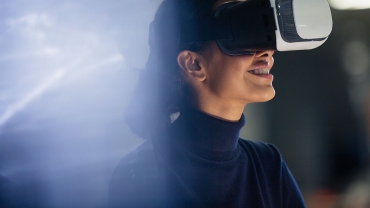
Our new analysis on virtual reality (VR) and augmented reality (AR) technology - collectively referred to as XR - titled ‘How UK organisations are using XR’, goes a long way towards showing that the business benefits of these technologies are real and all around us.
We researched publicly available information on 2.2 million UK organisations, looking for examples of XR use. After analysing 500 million points of data, using a natural language processing (NLP) tool, we populated our interactive map based on examples we identified via websites, press releases, social media messages and other public sources. The data was then organised in terms of industry, geography, technology and application.
This information will help shed some light on how organisations are using XR right now and provide inspiration to others who may just be starting their journey with XR technologies. It is crucial that businesses start exploring XR now because in less than a decade – by 2030 – XR is expected to boost global GDP by US$1.5 trillion (1.81% GDP). Our report, ‘Seeing is believing’, goes into detail about how these technologies are generating revenue and will continue to grow.
Three things immediately became apparent when reviewing the data:
- Every industry is benefiting from XR in some way
- VR is currently more mature than AR (although AR has greater longer-term market potential)
- XR is being used by organisations all over the UK
In the UK, the industries that lead the adoption of XR are engineering and manufacturing (24.13%), retail and consumer (10.90%) and professional services (10.65%).
The leading application category is consumer engagement (37.9%), which covers areas such as retail processes, consumer experiences and sales support, helping drive a greater connection between consumers and products and experiences from organisations.
Learning and development applications are the second-most prevalent use for XR in the UK (21.7%) helping organisations deliver real, measurable results on both soft skills and hard skills activities. We explore the former in detail in our ‘Effectiveness of Virtual Reality Soft Skills Training in the Enterprise’ study where we found VR to offer speed, confidence, emotional connection, and focus benefits to learners and cost benefits to organisations at scale.
| UK XR adoption by industry (top 5) | % | |
|---|---|---|
| 1 | Engineering and manufacturing | 24.13 |
| 2 | Retail and consumer | 10.90 |
| 3 | Professional services | 10.65 |
| 4 | Sports and leisure | 8.97 |
| 5 | Healthcare | 7.68 |
XR is a business tool and it’s ready to use
VR and AR are not there to replace existing processes and real-life events. Some things work better in person. But, COVID-19 has created challenges that have often led to many of us doing things in different ways. For example, video conferencing can substitute for face-to-face meetings. XR technology can, when appropriate, deliver value that a video conference cannot. Similarly, with training, there will always be cases where classroom training is best, but we have seen elearning has benefits as well. XR can enrich learning too. Like every business tool, XR should be used when the circumstances call for it.
Most encouragingly, there are impactful examples of XR being used across all UK regions and we predict adoption rates in regional areas to strengthen as organisations look to reduce costs but maintain effective remote working. In the UK, London is the primary hub for XR (with 33.2% of recorded examples), though there are secondary and tertiary hubs in other regions, such as the South East (14.7%) and the North West (8.7%). While London is the central hub for XR activity in the UK, the increasingly remote nature of work and the role of XR in enhancing this means that businesses can make connections with like-minded organisations and talent no matter the location.
If you don’t believe XR can benefit your organisation, you’re likely to be missing important opportunities. Get in touch with Jeremy Dalton who can help you to discover the value of XR for business and share more details about the examples featured on our XR map.








